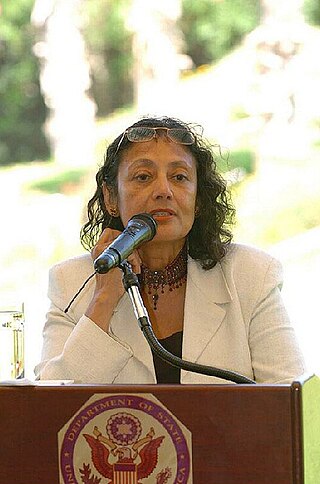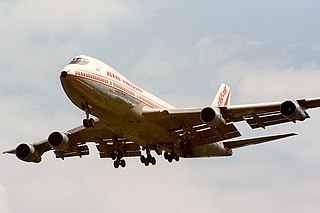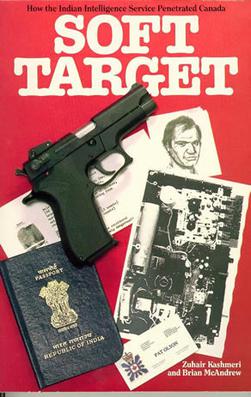
The Khalistan movement is a separatist movement seeking to create a homeland for Sikhs by establishing an ethno‐religious sovereign state called Khalistan in the Punjab region. The proposed boundaries of Khalistan vary between different groups; some suggest the entirety of the Sikh-majority Indian state of Punjab, while larger claims include Pakistani Punjab and other parts of North India such as Chandigarh, Haryana, and Himachal Pradesh. Shimla and Lahore have been proposed as the capital of Khalistan.
Clark Blaise, OC is a Canadian-American author. He was a professor of creative writing at York University, and a writer of short fiction. In 2010, he was named an Officer of the Order of Canada.

Bharati Mukherjee was an Indian American-Canadian writer and professor emerita in the department of English at the University of California, Berkeley. She was the author of a number of novels and short story collections, as well as works of nonfiction.

Air India Flight 182 was a passenger flight operating on the Montreal–London–Delhi–Bombay route, that on 23 June 1985, disintegrated over the Atlantic Ocean as a result of an explosion from a bomb planted by Canadian Sikh terrorists. It was operated using a Boeing 747-237B registered VT-EFO. The incident happened en route from Montreal to London at an altitude of 31,000 feet (9,400 m). The remnants of the aircraft fell into the sea approximately 190 kilometres off the coast of Ireland, killing all 329 people on board, including 268 Canadian citizens, 27 British citizens, and 24 Indian citizens. The bombing of Air India Flight 182 is the worst terrorist attack in Canadian history, the deadliest aviation incident in the history of Air India and was the world's deadliest act of aviation terrorism until the September 11 attacks in 2001. The mastermind behind the bombing was believed to be Inderjit Singh Reyat, a dual British-Canadian national, who pleaded guilty in 2003 and Talwinder Singh Parmar, a Canadian Sikh separatist leader, who was one of the key individuals associated with the militant group Babbar Khalsa, which were responsible for the bombing.

Babbar Khalsa International, better known as Babbar Khalsa, is a Sikh militant organisation that aims to create an independent Sikh nation of Khalistan in the Indian state of Punjab. It has used armed attacks, assassinations and bombings in aid of that goal, and is deemed to be a terrorist entity by various governments. Besides India, it operates in North America and Europe, including Scandinavia.

Talwinder Singh Parmar or Hardev Singh Parmar was a Sikh militant accused of masterminding the 1985 Air India Flight 182 bombing, which killed 329 people. It was the worst single incident of aviation terrorism in history until the September 11 attacks in the United States. In addition, another bomb was meant to explode aboard Air India Flight 301 in Japan the same day, but it exploded while the plane was still grounded, killing two people. Parmar was also the founder, leader, and Jathedar of Babbar Khalsa International (BKI), better known as Babbar Khalsa, a Sikh militant group involved in the Khalistan movement.

Terrorism in India, according to the Home Ministry, poses a significant threat to the people of India. Compared to other countries, India faces a wide range of terror groups. Terrorism found in India includes Islamic terrorism, ultranationalist terrorism, and left-wing terrorism India is one of the countries most impacted by terrorism.
Tara Singh Hayer was an Indian-Canadian newspaper publisher and editor who was murdered after his outspoken criticism of fundamentalist violence and terrorism. In particular, he was a key witness in the trial of the Air India Flight 182 bombing.
Guran Ditt Kumar, also known as G.D. Kumar Singh, was an Indian revolutionary associated with the pioneers of the Gadhar movement involved in the Indo-German conspiracy during the First World War.
Eisha Marjara is a Canadian film director and writer. With a background in photography, Marjara has written and directed several award-winning films, including the feature documentary Desperately Seeking Helen (1998) and The Incredible Shrinking Woman (1994). Marjara's forthcoming feature film is titled Venus; it has yet to be released.

Soft Target: How the Indian Intelligence Service Penetrated Canada is an investigative journalism book written by Canadian reporters Zuhair Kashmeri and Brian McAndrew. The authors define a "soft target" as "an espionage term used for any country, institution or group of people very easy to penetrate and manipulate for subversive purposes" and argue that the Canadian Sikh community was a soft target of a covert operation by the Indian government during the 1980s. The book also makes a claim that Indian intelligence agencies not only penetrated the Sikh community in order to discredit them worldwide and halt the momentum of the demand of an independent Sikh state, but also manipulated the Royal Canadian Mounted Police (RCMP) and Canadian Security Intelligence Service (CSIS).

The Dashmesh Regiment was a militant group, and is part of the Khalistan movement to create a Sikh homeland called Khalistan via armed struggle.

The International Sikh Youth Federation (ISYF) is a proscribed organisation that aims to establish an independent homeland for the Sikhs of India in Khalistan. It is banned as a terrorist organisation under Australian, European Union, Japanese, Indian, Canadian and American counter-terrorism legislation. The Government of India has declared it a terrorist organisation. While banned, the organization continues to receive financial support from many Sikh people based in Canada, the United States, and the United Kingdom.

Canada–India relations also referred to as Indo-Canadian relations, are the bilateral relations between Canada and India. Both Canada and India are member nations of the Commonwealth association, and also part of G20, a group of world's largest economies. Canada and India have had longstanding bilateral relations, with shared traditions such as democracy. India has become one of the top source countries for immigration to Canada with Indian diaspora increasing to over one million as of 2022. According to Immigration, Refugees and Citizenship Canada (IRCC) data, of the more than 800,000 international students in Canada in 2022, 40 per cent were from India, constituting the largest international student group in Canada. Bilateral trade between India and Canada has seen significant growth in recent years, reaching $8.16 billion in 2023.
The 1991 Toronto bomb plot refers to an Islamist terror plot that sought to attack two Toronto buildings - the India Centre cinema and the Vishnu Hindu temple, it was the first 'homegrown' Islamic terrorist plot on Toronto.

Lata Pada, CM is an Indian-born Canadian choreographer and Bharatanatyam dancer. Pada is the founder and artistic director of Sampradaya Dance Creations, a dance company that performs South Asian dance. She is also the founder and director of Sampradaya Dance Academy, a leading professional dance training institution that is the only South Asian dance school in North America affiliated with the prestigious, UK-based Imperial Society for Teachers of Dancing. Pada founded the dance company in 1990; Pada said that she founded the company because she wanted to showcase Bharatantyam dance as an art form throughout the world. Pada is known as an influential figure in South Asian-style dance in Canada.
In May 1986, five Canadian Sikhs were charged with plotting to blow up Air India Flight 112 in New York City. Ostensibly members of Babbar Khalsa, two were convicted and given life sentences, while three others were released. However, years later, the courts overturned the sentences and freed the remaining two men noting that the government had failed to disclose "crucial evidence" about the alleged plot, and defence lawyers argued that the men had been entrapped by police agents who invited them to a meeting, then suggested the crime, and arrested them for showing signs of agreement.
South Asian Canadians in the Greater Toronto Area form 19% of the region's population, numbering 1.1 million as of 2021. Comprising the largest visible minority group in the region, Toronto is the destination of over half of the immigrants coming from India to Canada, and India is the single largest source of immigrants in the Greater Toronto Area. South Asian Canadians in the region also include significant Pakistanis, Bangladeshis, Sri Lankans, and Nepalis, all representing several different ethnolinguistic backgrounds.
Air India 182 is a 2008 documentary directed by Sturla Gunnarsson, and produced by David York. It is about the Air India Flight 182 bombing in 1985. The Canadian Broadcasting Corporation commissioned the film, which originally had the preliminary title Flight 182. Gunarsson stated that he hoped the film would cause Canadians to contemplate domestic terrorism.
Desperately Seeking Helen is a 1998 documentary by Eisha Marjara, produced by the National Film Board of Canada.











